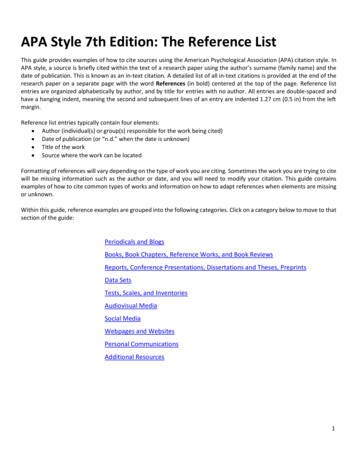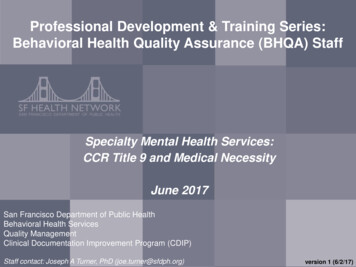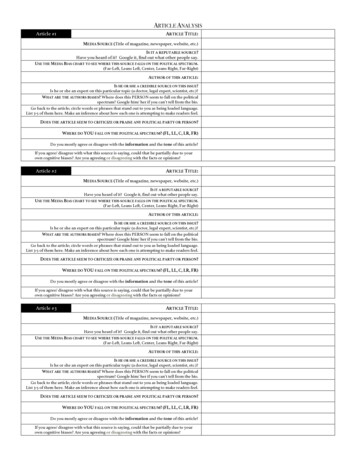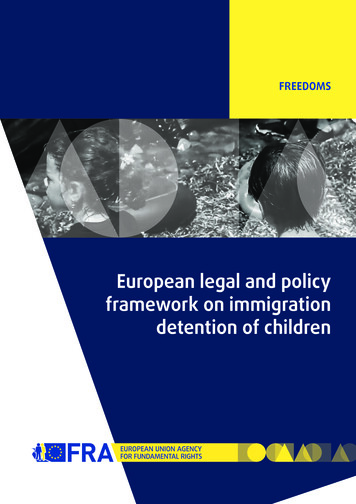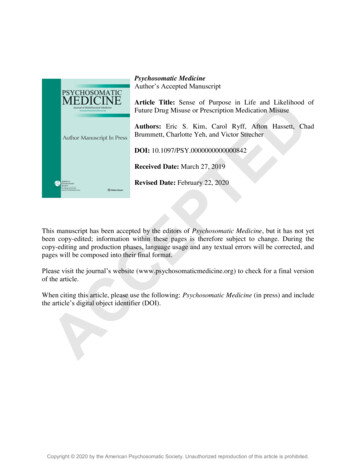
Transcription
Psychosomatic MedicineAuthor’s Accepted ManuscriptArticle Title: Sense of Purpose in Life and Likelihood ofFuture Drug Misuse or Prescription Medication MisuseDAuthors: Eric S. Kim, Carol Ryff, Afton Hassett, ChadBrummett, Charlotte Yeh, and Victor StrecherEPTEDOI: 10.1097/PSY.0000000000000842Received Date: March 27, 2019Revised Date: February 22, 2020This manuscript has been accepted by the editors of Psychosomatic Medicine, but it has not yetbeen copy-edited; information within these pages is therefore subject to change. During thecopy-editing and production phases, language usage and any textual errors will be corrected, andpages will be composed into their final format.CPlease visit the journal’s website (www.psychosomaticmedicine.org) to check for a final versionof the article.ACWhen citing this article, please use the following: Psychosomatic Medicine (in press) and includethe article’s digital object identifier (DOI).Copyright 2020 by the American Psychosomatic Society. Unauthorized reproduction of this article is prohibited.
Psychosomatic Medicine Publish Ahead of PrintDOI: 10.1097/PSY.0000000000000842Sense of Purpose in Life and Likelihood of Future Illicit Drug Use orPrescription Medication MisuseDEric S. Kim, PhD1,2,3,4, Carol Ryff, PhD5,6, Afton Hassett, PsyD7, Chad Brummett, MD7,1EPTECharlotte Yeh, MD8, Victor Strecher, PhD9Department of Social & Behavioral Sciences, Harvard T.H. Chan School of Public Health,Boston, MA; 2Lee Kum Sheung Center for Health and Happiness, Harvard T.H. Chan School ofPublic Health, Boston, MA; 3Program on Integrative Knowledge and Human Flourishing,Institute for Quantitative Social Science, Harvard University, Cambridge, MA; 4Department ofCPsychology, University of British Columbia, Vancouver, Canada, 5Department of Psychology,University of Wisconsin, Madison, WI; 6Institute on Aging, University of Wisconsin, Madison,CWI; 7Department of Anesthesiology, Michigan Medicine, University of Michigan, Ann Arbor,MI; 8AARP Service, Inc, Washington, DC; 9Department of Health Behavior & Health Education,AUniversity of Michigan School of Public Health, Ann Arbor, MICorrespondence and reprint requests to: Eric S. Kim, Department of Social and BehavioralSciences. Harvard T.H. Chan School of Public Health, 677 Huntington Avenue, Boston, MA02215, USA; Phone: 914-826-4477, email: eskim@hsph.harvard.eduCopyright 2020 by the American Psychosomatic Society. Unauthorized reproduction of this article is prohibited.
Conflicts of interest and source of funding: Research reported in this publication was supportedby the National Institutes of Health‘s National Institute on Aging (grant: K99AG055696). TheACCEPTEDauthors report no conflicts of interest.Copyright 2020 by the American Psychosomatic Society. Unauthorized reproduction of this article is prohibited.
AbstractObjective: In the United States, 28.6 million people used illicit drugs or misused prescriptiondrugs in the last 30 days. Thus, identifying factors linked with lower likelihood of future drugmisuse are important targets for research and practice. Sense of purpose in life has been linkedDwith better behavioral and physical health outcomes. Furthermore, a higher sense of purpose mayreduce likelihood of drug misuse because it has been linked with several protective factorsEPTEincluding: enhanced ability to handle stress, higher pain tolerance, and lower impulsivity.However, the association between sense of purpose and drug misuse has been understudied.Thus, we tested whether people with a higher sense of purpose at baseline had a lower likelihoodof future drug misuse 9-10 years later.Methods: This study included 3,535 middle-aged adults from the Midlife in the United StatesStudy (MIDUS) who were not misusing drugs at baseline. Using multiple logistic regressionCmodels, we assessed whether baseline purpose in life was associated with risk of misusing drugsC9-10 years later.AResults: Among respondents not misusing drugs at baseline, people in the highest quartile ofpurpose (versus lowest quartile) had substantially lower likelihood of future drug misuse in amodel adjusting for demographic variables (OR 0.50, 95% CI 0.31-0.83). Associationsremained evident after additionally adjusting for psychological distress, baseline health, andhealth behaviors.Copyright 2020 by the American Psychosomatic Society. Unauthorized reproduction of this article is prohibited.
Conclusions: A growing knowledge base suggests that a sense of purpose can be increased.Additional research is needed to evaluate sense of purpose as a novel target in the prevention andreduction of drug misuse.EPTEDKey Words: purpose in life, drug misuse, psychological well-being, substance abuseAcronymsHRS: Health and Retirement StudyMIDUS: Midlife in the United States StudyMIDUS R: Midlife in the United States Study RefresherSD: Standard DeviationSAMHSA: Substance Abuse and Mental Health Services AdministrationCNSDUH: National Survey on Drug Use and HealthCNHSDA: National Household Survey on Drug AbuseCIDI-SF: Composite International Diagnostic Interview Short Form ScaleAGED: General Educational DevelopmentEFTF: Enhanced Face-to-FaceIRB: Institutional Review BoardCopyright 2020 by the American Psychosomatic Society. Unauthorized reproduction of this article is prohibited.
In the United States, an estimated 28.6 million people used illicit drugs or misusedprescription drugs in the last 30 days (1). This growing drug epidemic negatively impacts societythrough many pathways, including: diminished mental, behavioral, and physical health as wellhigher: healthcare costs, motor vehicle accidents, child abuse/neglect, and violence/crime (2).Currently, U.S. life expectancy ranks 27th out of the 36 Organization for Economic CooperationDand Development (OECD) countries. According to a recent Surgeon General report, a substantialportion of this low ranking is attributable to substance misuse and the array of problems that itEPTEunleashes (2). Thus, a central challenge is to identify potentially modifiable factors that mayreduce the likelihood of drug misuse, of whatever type, and among diverse age cohorts ofadults—a need particularly critical in the current climate. Additionally, the number of middleaged adults and older adults experiencing problems with substance misuse is growing rapidlyand thus is an age group that needs particular attention (3).A growing body of research shows that psychological well-being is independentlyCassociated with a wide range of enhanced health outcomes and behaviors (4–6). In particular,Cpurpose in life—the extent to which individuals see their lives as having meaning, a sense ofdirection, and broader goals to live for (4,7–11), has been associated with lower risk of chronicAconditions (e.g., cognitive impairment, stroke, cardiovascular events) (12–19), higher likelihoodof engaging in healthier behaviors (e.g., higher: physical activity, use preventive healthscreenings, medication adherence) (20–22), better biologic function (e.g., lower allostatic load,enhanced glucoregulation) (23–25), and lower risk of mortality (16). Past research also finds thata higher sense of purpose is associated with protective factors that reduce the likelihood of drugmisuse, including: higher ability to handle stress, higher pain tolerance, lower impulsivity, andCopyright 2020 by the American Psychosomatic Society. Unauthorized reproduction of this article is prohibited.
lower risk of depression and chronic conditions (26–30). Together, these studies suggest thathaving a higher sense of purpose in life influences key protective factors likely to reduce drugmisuse. Although purpose in life is shaped by social structural factors and changing lifecircumstances, several studies suggest that purpose can potentially be modified using methodsthat range from volunteering to group programs organized around cognitive behavioral therapyEPTEintervention efforts aimed at reducing drug misuse.Dbased modules (4,31–35). Thus, it might be a novel and promising target for prevention andA small number of pioneering studies have contributed substantially to this literature bydemonstrating links between a higher sense of purpose and lower risk of drug misuse (36–42);while findings are suggestive, they are limited in a number of ways. First, all studies used datafrom specific subpopulations (e.g., high school or college students, people from drug recoveryprograms), and we do not know if those results generalize to healthy populations, or adultsbeyond their early 20‘s. Second, all studies had cross-sectional designs except for two—oneCamong cocaine users in a residential treatment program, and the other among people in theirCearly 20‘s. Third, most studies had smaller sample sizes. Fourth, many studies did not adequatelyaccount for potential confounders (e.g., demographics, psychological distress, baseline health).AFifth, some studies used measures of purpose in life that have not been psychometricallyevaluated. Thus, additional work is needed, in larger, representative, and prospective studies,with more control for potential confounders, and the use of validated purpose in life measures.We built upon these important studies and used data from the Midlife in the United StatesStudy to test whether a higher sense of purpose in life was associated with lower drug misuseCopyright 2020 by the American Psychosomatic Society. Unauthorized reproduction of this article is prohibited.
over time. We also used data from the Health and Retirement Study, to test a complementaryhypothesis that would provide potential insight into a mechanism, whether a higher sense ofpurpose in life was associated with lower likelihood of drug misuse to cope with stress.METHODSDStudy SampleMIDUS. Data were from the Midlife in the United States (MIDUS) study, an ongoingEPTEnationally representative study of U.S. adults begun in 1995 with the aim of investigatingbiopsychosocial processes of aging. At baseline (MIDUS 1), 7,108 non-institutionalized adults(ranging in age from 25-74) were surveyed via a telephone interview and self-administeredquestionnaire. Two follow-up interviews (each approximately 9-10 years later) were completedto create MIDUS 2 and 3. After adjusting for mortality, longitudinal retention rates for bothfollow-up waves were 75%. Since data on drug misuse and the full purpose in life measure werefirst assessed in MIDUS 2, this study focuses on data from MIDUS 2 (baseline for this study)Cand the MIDUS 3 follow-up interview. Additionally, in 2012 a new national sample of 3,577CU.S. adults (also aged 25-74) was recruited (the MIDUS Refresher (MIDUS R). Data fromMIDUS R are included here to assess the consistency of findings obtained from the mainAanalyses. The final analytic samples were n 3,535 (for MIDUS 2/MIDUS 3) and n 2,591 (forMIDUS R); Figures S1 and S2 describe inclusion criteria for each sample in detail.HRS. Data were also from the Health and Retirement Study (HRS), an ongoing nationallyrepresentative panel study of US adults aged 50 that began in 1992 and re-interviews peopleevery two years. Starting in 2006, a random 50% of the HRS longitudinal panel was selected forCopyright 2020 by the American Psychosomatic Society. Unauthorized reproduction of this article is prohibited.
an enhanced face-to-face (EFTF) interview (and the other half was interviewed in 2008) (43).After the interview, respondents were given a self-report psychosocial questionnaire that theycompleted and returned by mail. Information about drug misuse as a method of coping was onlyasked in an experimental module in 2008; these modules were administered to random subsets ofHRS members at each wave. Our analyses were restricted to those who completed this moduleDand the psychosocial questionnaire. The final analytic sample was 511; Figure S4 describesEPTEinclusion criteria.Extensive documentation about the protocol, instrumentation, and sampling strategy existfor both MIDUS (http://www.midus.wisc.edu/) and HRS (http://hrsonline.isr.umich.edu/).Because the study used de-identified, publicly available data, the Harvard T.H. Chan School ofPublic Health IRB exempted it from review.MeasuresCPurpose in life. Purpose in life was assessed in MIDUS 2, the MIDUS Refresher, and inCthe 2008 wave of HRS using the seven-item purpose in life subscale from the Ryff PsychologicalWell-Being Scales, previously validated in a nationally representative sample of adults (44). OnAa seven-point Likert scale (in MIDUS) and six-point Likert scale (in HRS) respondents rated thedegree to which they endorsed seven items (e.g., ―I have a sense of direction and purpose in mylife‖). The sum of all seven items was taken to create a scale where higher scores reflected higherlevels of purpose (Cronbach α 0.72 in MIDUS; Cronbach α 0.74 in HRS). To facilitatecomparison of effect size across studies, we standardized scores derived for the current studyCopyright 2020 by the American Psychosomatic Society. Unauthorized reproduction of this article is prohibited.
(M 0, SD 1). Furthermore, to examine the possibility of threshold effects we created quartilesbased on the baseline distribution of purpose scores in the sample.Drug Misuse. Drug misuse was assessed in MIDUS 2, MIDUS 3, and MIDUS R, usingquestions developed by the Substance Abuse and Mental Health Services AdministrationD(SAMHSA) for use in its annual nationwide survey on drug misuse: the National Survey onDrug Use and Health (NSDUH; formerly known as the National Household Survey on DrugEPTEAbuse (NHSDA)) (45). The survey asked participants (yes/no) if they used any of the following10 categories of substances in the past 12 months: without a doctor‘s prescription, in largeramounts than prescribed, or for a longer period than prescribed: 1) Sedatives, 2) Tranquilizers, 3)Amphetamines, 4) Painkillers, 5) Anti-depressants, 6) Inhalants, 7) Marijuana, 8) Cocaine, 9)Hallucinogens, 10) Heroin. Participants were considered drug misusers if they reported using anyof these substances. See Methods and Results in the Supplemental Digital Content for furtherCdetails about this assessment.CMisuse of Drugs to Cope. Misuse of drugs to cope was assessed during the 2008 wave ofHRS in an experimental module using a question adapted from the National Survey of BlackAAmericans (46). Study participants were given the following prompt: ―Because of all thedemands of work, home, family or friends, we all feel stressed at times. The following questionsask about things you are most likely to do after having what you think is a stressful event orday,‖ then HRS participants were asked the degree to which they endorsed using ―prescription orother drugs to help make it [stress] easier to bear,‖ on a 5-point Likert scale ranging from―never‖ ( 1) to ―very often‖ ( 5). Due to the low number of people in each Likert-scaleCopyright 2020 by the American Psychosomatic Society. Unauthorized reproduction of this article is prohibited.
category, the cell sizes were not large enough for analyses; thus, we re-categorized the outcomeinto a yes/no binary—anyone outside the ―never‖ category was considered to be misusing drugsto cope.Potential Confounders. Potential confounders included demographic variables,Dpsychological distress, baseline health factors, and health behaviors. All covariates were assessedby self-report in MIDUS 2, MIDUS R and HRS (in 2008); unless otherwise noted, they wereEPTEcoded in the same way. Please see Methods and Results in the Supplemental Digital Content formore detailed information about several of the variables. Demographic factors included: age(continuous), sex (male/female), race/ethnicity (White, African-American, Other), marital status(married/not married), educational attainment ( high school, GED or high school diploma, college degree), total income (in MIDUS) or total wealth (in HRS; both based on quintiles ofthe score distribution), health insurance (yes/no), and employment status (yes/no). Psychologicaldistress included: depression (in MIDUS: the Composite International Diagnostic InterviewCShort Form Scale (CIDI-SF) (47) and in HRS: the Center for Epidemiologic Studies DepressionCScale) (48), anxiety (in MIDUS: generalized anxiety disorder was assessed using the CIDI-SF(47,49) and in HRS: elevated anxiety was assessed in the Beck Anxiety Inventory) (47,48), andAlifetime stressors. We included a wide range of baseline health factors as they are risk factors forincreased risk of drug misuse and potential confounders. Baseline health factors included:number of nights the participant was a patient in a hospital overnight (MIDUS asked about thepast one year, HRS asked about the past two years), chronic pain, and chronic conditions ((defined as having 1 [yes/no] of the following conditions (see Methods and Results in theSupplemental Digital Content for full list)) and assessed via participants report of a doctor‘sCopyright 2020 by the American Psychosomatic Society. Unauthorized reproduction of this article is prohibited.
diagnosis, number of nights participant was a patient in a hospital overnight (MIDUS askedabout the past one year, HRS asked about the past two), and chronic pain. Health behaviorsincluded current (yes/no): self-reported drinking or smoking.Statistical AnalysisDIn MIDUS, we used logistic regression to evaluate the likelihood of future drug misuse(yes/no) at follow-up among participants who did not report drug misuse at baseline. WeEPTEevaluated 4 models for all our analyses. Model 1 adjusted for age. Model 2, the demographicmodel, included age, sex, race/ethnicity, marital status, educational attainment, income/totalwealth, health insurance, and employment status. We then considered the outcome ofsequentially adding other potential confounders, including baseline health (chronic conditions,chronic pain, number of nights hospitalized) and psychological distress (depression, anxiety,lifetime stressors; model 3). The last model additionally adjusted for health behaviors (currentdrinker, current smoker; model 4). In all analyses, purpose in life was first considered as aCcontinuous, and then as a categorical variable (quartiles). Analyses were conducted in StataCversion 15.0.AAdditional AnalysesWe ran four additional analyses. First, we evaluated if a similar association betweenpurpose and drug misuse would be observed in the MIDUS Refresher cohort (MIDUS R), a newcohort created to augment the existing MIDUS study with a new national sample recruited 18years after the initial baseline sample (MIDUS 1). MIDUS R did not have follow-up data, thusanalyses were cross-sectional. Second, we also evaluated the cross-sectional association betweenCopyright 2020 by the American Psychosomatic Society. Unauthorized reproduction of this article is prohibited.
purpose and drug misuse in MIDUS 2. Third, In HRS, we used logistic regression to evaluate thelikelihood of drug misuse to cope with stress. Fourth, to evaluate the potential presence of effectmodification by age, we included an interaction term for age x purpose in life.Missing DataDIn MIDUS, we imputed missing data on all covariates and outcomes using an imputationby chained equations multiple imputation procedure (and generated 5 datasets) as this methodEPTEprovides a more accurate estimate of association than other methods of handling missing datasuch as complete-case analyses (52–55). In HRS, we did not use multiple imputation because 5% of study respondents were dropped in complete-case-analyses.RESULTSDescriptive StatisticsAmong non-drugs users at baseline in MIDUS 2, the average age of respondents was 57Cyears (SD 13.4) and they were primarily women (55%) and college-educated, or more (63%).CFurthermore, 8.8% reported misusing drugs at follow-up 9-10 years later. In HRS, the averageage of respondents at study baseline was 71 years (SD 9.0) and they were primarily womenA(60%) and high school educated (54%). Additionally, 14.5% reported misusing drugs to copewith stress. Table 1 provides further descriptive statistics. Table S1 provides further informationabout how much each substance was misused and Table 2 provides information on thepercentage of respondents who misused multiple substances.Copyright 2020 by the American Psychosomatic Society. Unauthorized reproduction of this article is prohibited.
Purpose in Life and Future Drug MisuseAmong MIDUS 2 respondents who were not misusing drugs at baseline, each standarddeviation increase in purpose in life was associated with 22% lower odds (95% CI: 0.65, 0.92;Table 2) of future drug misuse 9-10 years later (in MIDUS 3), after adjusting for demographicfactors. When considering quartiles of purpose in life, we observed a graded relationshipDbetween increasing quartiles of purpose and decreasing likelihood of future drug misuse in allmodels. For example, in the demographic factors model, compared to adults in the lowestEPTEpurpose in life quartile, those in the middle-high purpose quartile had 35% lower odds (95% CI:0.39, 1.08) of future drug misuse, while those in the highest quartile had 50% lower odds (95%CI: 0.31, 0.83). When purpose was considered as a continuous variable or in quartiles,associations between purpose in life and future drug misuse were consistent and persisted acrossall 4 covariate models. See Methods and Results in the Supplemental Digital Content for resultsfrom the cross-sectional analyses in the MIDUS Refresher sample (Tables S2 and S3). Thepattern of results for both sets of cross-sectional results were largely similar to the longitudinalCCresults, but slightly stronger in magnitude.AAdditionally, there was no interaction between purpose and age (P for interaction 0.87).Purpose in Life and Misuse of Drugs to Cope with StressIn HRS, each standard deviation increase in purpose in life was associated with 39%lower odds (95% CI: 0.47, 0.80; Table 3) of misusing drugs to cope with stress in thedemographic factors model. When considering quartiles of purpose in life, we again observed aCopyright 2020 by the American Psychosomatic Society. Unauthorized reproduction of this article is prohibited.
graded relationship. When purpose was considered as a continuous variable or in quartiles, themain association of interest was consistent and persisted across all 4 models.DISCUSSIONWe observed a strong relationship between increasing levels of baseline purpose in lifeD(MIDUS 2) and decreasing likelihood of future drug misuse at 9-10-year follow-up (MIDUS 3).In a second cohort (MIDUS R), we observed the same pattern. In a third cohort (HRS), weEPTEobserved a strong relationship between increasing levels of purpose in life and decreasinglikelihood of misusing drugs to cope with stress—providing complementary evidence to ourmain findings. Future research should further evaluate this latter finding as a potentialmechanism using longitudinal data and formal mediation methods. All three sets of findingswere maintained after close control for potential confounding factors, including demographicvariables, and still evident (although attenuated), even after further adjustment for psychologicaldistress, baseline health, and health behaviors. Our findings are consistent with results from twoCbodies of research that have evaluated the association between higher purpose and: 1) lower riskCof drug misuse (33–39),.as well as 2) higher likelihood of recovery from drug misuse or alcoholAdependence (56–58).Although the mechanisms underlying these findings are unclear, mounting research findsthat people with a higher sense of purpose differ on numerous processes known to predict drugmisuse, including: higher ability to handle stress, higher pain tolerance, lower impulsivity, andlower risk of depression and chronic conditions. Evidence suggests that a higher sense ofpurpose in life buffers against stress through enhanced emotion regulation. For example, peopleCopyright 2020 by the American Psychosomatic Society. Unauthorized reproduction of this article is prohibited.
with higher purpose have a slower eye-blink startle reflex in response to negative picture stimuliand faster recovery to pre-stress cortisol levels after exposure to acute social laboratory stressors(23,24). Moreover, a recent daily diary study observed that on days when people faced higheramounts of daily stressors, those with higher purpose displayed less pronounced spikes innegative affect and physical symptoms (30). Thus, having a higher sense of purpose may reduceDthe likelihood of drug misuse due to an enhanced ability to cope with and/or recover from dailystressors. Additional research shows that people with a higher sense of purpose display anEPTEenhanced ability to habituate to pain (28), which may in turn decrease the need for analgesics.People with high purpose also display a heightened ability to curb impulsivity (29), which mayin turn help reduce the likelihood of drug misuse. Higher purpose has also been associated withlower risk of depression and several chronic conditions (e.g., cardiovascular events, Alzheimer‘sdisease)—(15,16) that are additional risk factors for future drug misuse. Although the temporalordering of our data did not allow us to accurately test potential mechanisms, future researchCwith appropriate data should.COur study has several limitations. Confounding by unmeasured variables is a limitation inobservational research; however, findings were maintained after careful control for multipleAdemographic factors, psychological distress, baseline health, and health behaviors. Biasedestimates due to attrition may be a problem because people who start misusing drugs are morelikely to drop out; however we used a multiple imputation method that helps alleviate thisconcern (49–52). Our drug misuse assessment asked about misuse only in the past 12 months.Although we tried limiting potential confounding introduced by prior drug misuse, we wereunable to exclude people who misused drugs 12 months ago due to the wording of the drugCopyright 2020 by the American Psychosomatic Society. Unauthorized reproduction of this article is prohibited.
misuse assessment. Furthermore, due to the nature of the drug misuse assessment, we wereunable to differentiate between important nuances including: 1) initiation, 2) maintenance, 3)cessation, and 4) relapse to drug misuse; each of these behavioral processes might be influencedby different dynamics and future research should evaluate these nuances. The range of misuseddrugs examined in MIDUS is broad, but due to power issues, we were unable to evaluate specificDdrug categories; future research should evaluate this question as some of the drugs evaluated areriskier than others and have more adverse effects. Moreover, intensity nor frequency of drugEPTEmisuse was assessed and should be investigated in future work. Future research should alsoevaluate potential mechanisms underlying the purpose in life and drug misuse association.Finally, these cohorts are representative of middle- and older-aged adults and results may notgeneralize to younger populations.This study also has considerable strengths. Data were from large, prospective, diverse,and national samples of U.S. adults. Furthermore, MIDUS is one of the few studies with detailedCinformation about purpose in life, a broad set of relevant risk factors, and measures of drugCmisuse over time. Additionally, both the primary exposure, and outcome, were assessed withvalidated and widely used measures. The prospective nature of our data reduces potentialAconcerns that the associations reported in this study are attributable to reverse causation orretrospective reporting bias. Evidence of a purpose-drug misuse association in a completelyindependent sample (MIDUS Refresher) is another strength, as is complementary evidence froma third dataset (HRS).Healthcare professionals are struggling to contain the growing drug epidemic in theCopyright 2020 by the American Psychosomatic Society. Unauthorized reproduction of this article is prohibited.
United States and a comprehensive and multidisciplinary effort is needed. Although much moreresearch is required, emerging research suggests that a sense of purpose in life might serve as anovel target for prevention (e.g., screener may help identify those vulnerable to future drugmisuse) and multi-level intervention efforts aimed at stemming the tide of our nation‘s growingACCEPTEDdrug epidemic.Copyright 2020 by the American Psychosomatic Society. Unauthorized reproduction of this article is prohibited.
Grants / Financial Support: Research reported in this publication was supported by the NationalInstitutes of Health‘s National Institute on Aging (grant: K99AG055696).Role of the Sponsor: The funding sources had no influence on the design or conduct of the study;collection, management, analysis or interpretation of the data; or preparation, review, or approvalDof the manuscript. All authors had full access to all data in the study and takes responsibility forthe integrity of the data and the accuracy of the data analysis. All authors contributed to theEPTEdesign of the study and interpretation of the findings, and have read, commented on, andapproved the manuscript.Disclosures: There are no conflicts of interest.Acknowledgements: We would like to acknowledge the Midlife in the United States Study,which is conducted at the University of Wisconsin, with grants from John D. and Catherine T.CMacArthur Foundation Research Network and the National Institute on Aging (P01AG020166 &CU19AG051426). We would also like to acknowledge the Health and Retirement Study, which isconducted by the Institute for Social Research at the University of Michigan, with grants fromAthe National Institute on Aging (U01AG09740) and the Social Security Administration.Copyright 2020 by the American Psychosomatic Society. Unauthorized reproduction
Psychosomatic Medicine Publish Ahead of Print DOI: 10.1097/PSY.0000000000000842 . IRB: Institutional Review Board . Public Health IRB exempted it from review. Measures Purpose in life. Purpose in life was assessed in MIDUS 2, the MIDUS Refresher, and in



